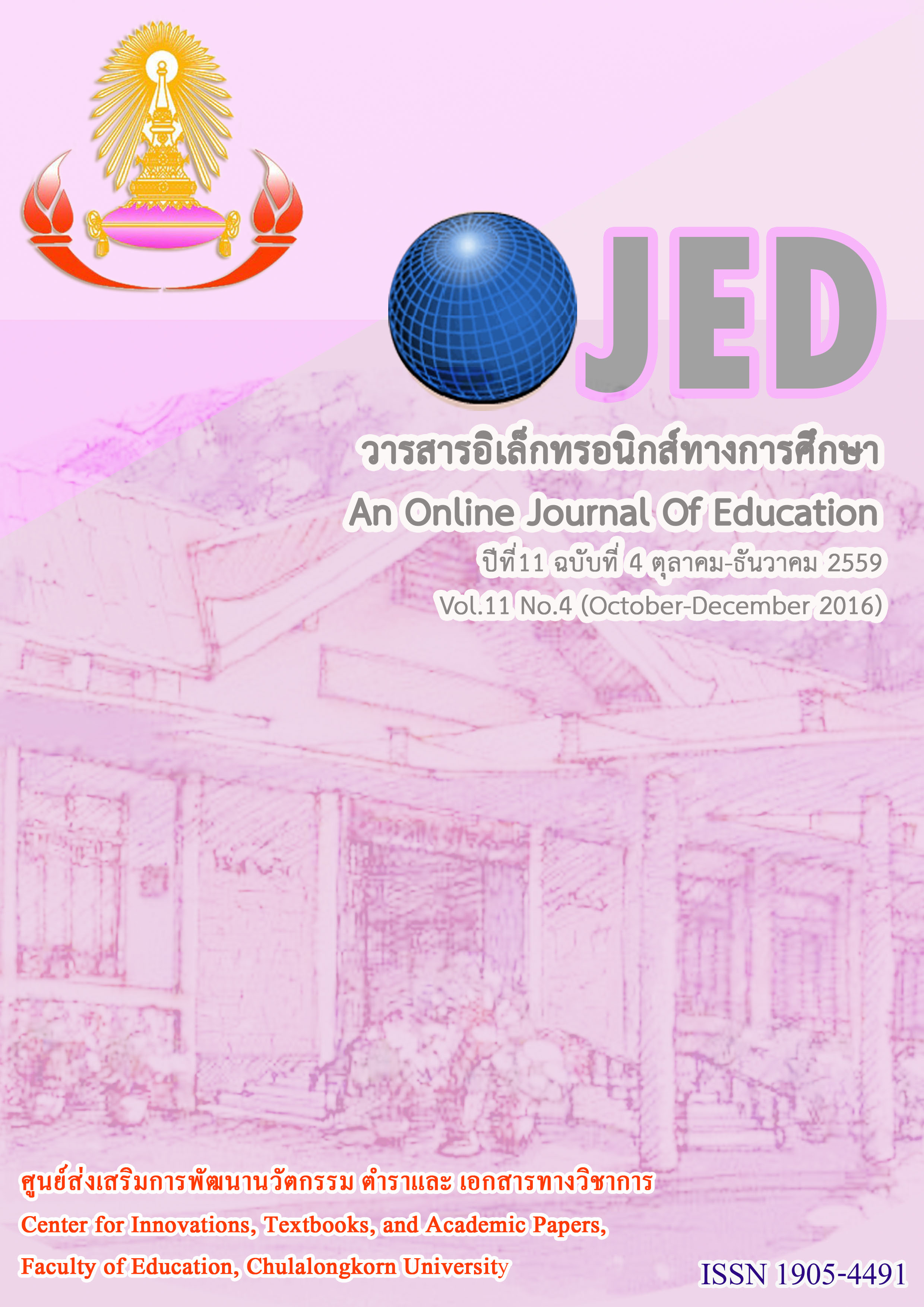อิทธิพลของวิธีวัดแบบมาตราส่วนประมาณค่าและบังคับเลือก ที่มีต่อความเที่ยงและความตรงเชิงโครงสร้างในการวัดบุคลิกภาพ 5 องค์ประกอบ EFFECTS OF RATING SCALE AND FORCED-CHOICE FORMAT MEASUREMENT METHODS ON THE QUALITY OF RELIABILITY AND CONSTRUCT VALIDITY IN THE
Keywords:
อิทธิพลของวิธีวัด, บุคลิกภาพ 5 องค์ประกอบ, มาตราส่วนประมาณค่า, บังคับเลือก, เทคนิค CEUL, เทคนิค CTCM, EFFECTS OF MEASUREMENT METHODS, BIG FIVE PERSONALITY TRAITS, RATING SCALE, FORCED-CHOICE FORMAT, CEUL TECHNIQUES, CTCM TECHNIQUESAbstract
การวิจัยครั้งนี้มีวัตถุประสงค์คือ 1) เพื่อเปรียบเทียบความเที่ยงของแบบวัดบุคลิกภาพ 5 องค์ประกอบแบบมาตราส่วนประมาณค่าและบังคับเลือก 2) เพื่อตรวจสอบความตรงเชิงโครงสร้างของแบบวัดบุคลิกภาพ 5 องค์ประกอบแบบมาตราส่วนประมาณค่าและบังคับเลือกและ 3) เพื่อวิเคราะห์อิทธิพลของวิธีวัดบุคลิกภาพ 5 องค์ประกอบ
แบบมาตราส่วนประมาณค่าและบังคับเลือกโดยใช้เทคนิค Controlling for the effects of an unmeasured latent methods factor: CEUL และเทคนิค Controlling for the effects with correlated trait factor and correlated method factor: CTCM กลุ่มตัวอย่างคือนักเรียนชั้นมัธยมศึกษาปีที่ 6 ในโรงเรียนสังกัดสำนักงานเขตพื้นที่การศึกษามัธยมศึกษากรุงเทพมหานคร รวมทั้งหมด 1,200 คน เครื่องมือที่ใช้ในการวิจัยคือแบบวัดบุคลิกภาพ 5 องค์ประกอบแบบมาตราส่วนประมาณค่าและบังคับเลือก วิเคราะห์ข้อมูลด้วยการทดสอบ z-test และการวิเคราะห์องค์ประกอบ
เชิงยืนยัน
ผลการวิจัยสรุปได้ดังนี้ 1) ความเที่ยงแบบความสอดคล้องภายในโดยใช้ค่าสัมประสิทธิ์แอลฟาของครอนบาคของแบบวัดบุคลิกภาพ 5 องค์ประกอบแบบมาตราส่วนประมาณค่าสูงกว่าบังคับเลือกอย่างมีนัยสำคัญทางสถิติที่ระดับ .01, ความเที่ยงแบบความคงที่โดยใช้ค่าสหสัมพันธ์แบบเพียร์สันของแบบวัดบุคลิกภาพ 5 องค์ประกอบแบบบังคับเลือกสูงกว่ามาตราส่วนประมาณค่าอย่างมีนัยสำคัญทางสถิติที่ระดับ .01 2) ผลการวิเคราะห์องค์ประกอบเชิงยืนยันของ
แบบวัดบุคลิกภาพ 5 องค์ประกอบแบบมาตราส่วนประมาณค่า (CFA-R) และบังคับเลือก (CFA-F) ไม่สอดคล้องกับข้อมูลเชิงประจักษ์ อย่างไรก็ตามเมื่อปรับโมเดลแล้ว โมเดล CFA-F สอดคล้องกับข้อมูลเชิงประจักษ์มากกว่าโมเดล
CFA-R อย่างมีนัยสำคัญทางสถิติที่ระดับ .01 แต่ความตรงเชิงโครงสร้างของโมเดล CFA-F มีความคลาดเคลื่อน
(Chi-square = 2,442.08, df = 1,650, Chi-square/df = 1.48, RMSEA = .020, GFI = .94) และ 3) ผลการวิเคราะห์อิทธิพลของวิธีวัดบุคลิกภาพ 5 องค์ประกอบแบบมาตราส่วนประมาณค่าและบังคับเลือกโดยใช้เทคนิค CEUL มีความสอดคล้องกับข้อมูลเชิงประจักษ์และเหมาะสมมากกว่าเทคนิค CTCM (R-MR-CEUL; Chi-square = 11,207.09,
df = 1,640, Chi-square/df = 6.83, RMSEA = .070, GFI = .76)
The purposes of this research were: 1) to compare the reliability of the big five personality traits measurement on the rating scale and forced-choice format, 2) to validate the construct validity of the big five personality traits measurement on the rating scale and forced-choice format and 3) to analyze the effects of the measurement methods (the rating scale and forced-choice format) of the big five personality traits measured by controlling for the effects of an unmeasured latent methods factor (CEUL) and controlling for the effects with correlated trait factor and correlated method factor (CTCM). The sample consisted of 1,200 students in grade 12 from the school under the Basic Education Commission, Bangkok. The research instruments consisted of the big five personality traits measured by the rating scale and forced-choice format. Data analysis were conducted by using z-test and confirmatory factor analysis.
The results of this research were as follows: 1) the internal consistency reliability using Cronbach’s alpha coefficient of the big five personality traits measurement on the rating scale was higher than the reliability of the forced-choice format at the .01 level of significance, the stability reliability by using the Pearson product moment correlation coefficient of the big five personality traits measurement on the forced-choice format was higher than the reliability of the rating scale at the .01 level of significance, 2) the results of confirmatory factor analysis of the big five personality traits measured by the rating scale model (CFA-R) and forced-choice format model (CFA-F) did not fit the empirical data, however, after the models were adjusted, the CFA-F model fit the empirical data more than the CFA-R model at the .01 level of significance, but the construct validity of the CFA-F model was distorted (Chi-square = 2,442.08, df = 1,650, Chi-square/df = 1.48, RMSEA = .020, GFI = .94) and 3). The analysis results showed that the effects of the rating scale and forced-choice format measurement methods of the big five personality traits measured using CEUL techniques fit the empirical data and were more appropriate than using CTCM techniques (R-MR-CEUL; Chi-square = 11,207.09, df = 1,640, Chi-square/df = 6.83, RMSEA = .070, GFI = .76).




